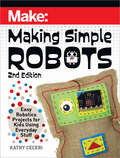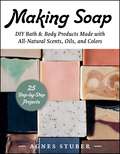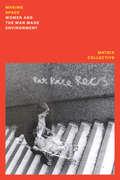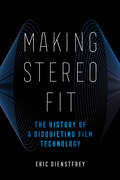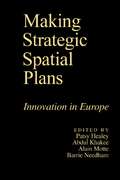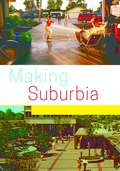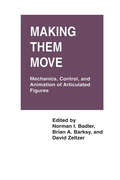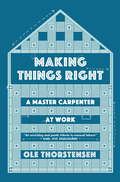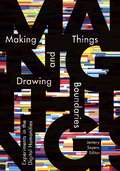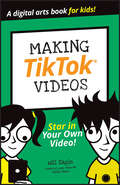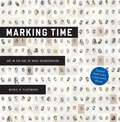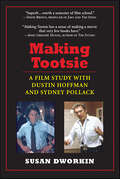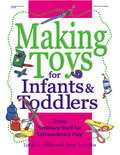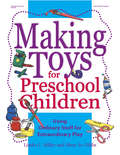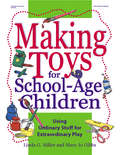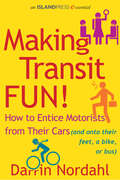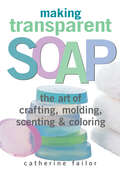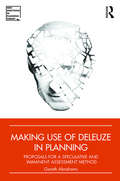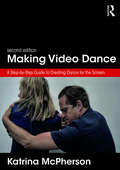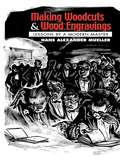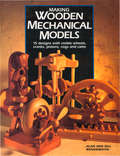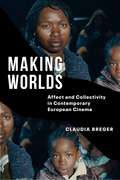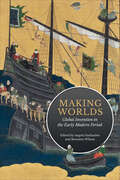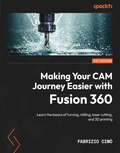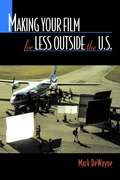- Table View
- List View
Making Simple Robots: Easy Robotics Projects for Kids Using Everyday Stuff
by Kathy CeceriMaking Simple Robots is based on the idea that anybody can build a robot! That includes kids, educators, parents, and anyone who didn't make it to engineering school. If you can cut, fold, and tape a piece of paper to make a tube or a box, you can build a no-tech robotic part. In fact, many of the models in this book are based upon real-life prototypes -- working models created in research labs and companies. What's more, if you can use the apps on your smartphone, you can quickly learn to tell robots what to do using free, online, beginner-level software like MIT's Scratch and Microsoft MakeCode.The projects in this book which teach you about electric circuits by making jumping origami frogs with eyes that light up when you get them ready to hop. You'll practice designing all-terrain robot wheel-legs with free, online Tinkercad software, and you'll create files ready for 3D printing. You'll also learn to sew -- and code -- a cyborg rag doll with a blinking electronic "eye."Each project includes step-by-step directions and clear illustrations and photographs. Along the way, you'll learn about the real research behind the DIY version, find shortcuts for making projects easier when needed, and get suggestions for adding to the challenge as your skill set grows.
Making Soap: DIY Bath & Body Products Made with All-Natural Scents, Oils, and Colors
by Agnes StuberWelcome to the world of homemade soap! It is perfectly possible to make soap at home—from simple everyday soaps to fragrant masterpieces. Making Soap describes what cold-stirred craft soap is, why it works, what you need, and how to make it. Read about fatty acids, essential oils, natural dyes, and other materials that give soap its characteristics. Recipes include: Scrubbing poppy soap Facial soap with activated charcoal Skin-softening bath bomb Rosy clay soap And so much more! Learn how to make your own soap from ingredients you already have at home with Making Soap.
Making Space: Women and the Manmade Environment
by MatrixTimely re-issue of the groundbreaking manifesto for feminist architectureMaking Space is a pioneering work first published in 1984 which challenges us to look at how the built environment impacts on women&’s lives. It exposes the sexist assumptions on gender and sexuality that have a fundamental impact on the way buildings are designed and our cities are planned.Written collaboratively by the feminist collective Matrix, tthe book provide a full blown critique of the patriarchal built environment both in the home and in public space, and outline alternative forms of practice that are still relevant today. Making Space remains a path breaking book pointing to possibilities of a feminist future.Some authors worked for the London-based Matrix Feminist Architect&’s collective, an architectural practice set up in 1980 seeking to establish a feminist approach to design. They worked on design projects—such as community, children and women&’s centres. Others were engaged in building work, teaching and research.The new edition comes with a new introduction examining the context, process and legacy of Making Space written by leading feminists in architecture.
Making Stereo Fit: The History of a Disquieting Film Technology (California Studies in Music, Sound, and Media #6)
by Eric DienstfreySurround sound is often mistaken as a relatively new phenomenon in cinemas, one that emerged in the 1970s with the arrival of Dolby. Making Stereo Fit reveals that, in fact, filmmakers have been creating stereo and surround-sound effects for nearly a century, since the advent of talking pictures, and argues that their endurance owes primarily to the longstanding battles between stereo and mono technologies. Throughout the book, Eric Dienstfrey analyzes newly discovered archival materials and myriad stereo releases, from Hell’s Angels (1930) to Get Out (2017), to show how Hollywood’s financial dependence on mono prevented filmmakers from seeing surround sound’s full aesthetic potential. Though studios initially explored stereo’s unique capabilities, Dienstfrey details how filmmakers eventually codified a conservative set of surround-sound techniques that prevail today, despite the arrival of more immersive formats.
Making Strategic Spatial Plans
by Barrie Needham Patsy Healey Abdul Khakee Alain MotteA pan-European survey of strategic planning issues in response to technological innovation and its spatial consequences, this text should interest all planners, geographers and others concerned wtih the planning and management of economic development.
Making Suburbia: New Histories of Everyday America
by Katherine Solomonson John Archer Paul J. P. SandulWhat are the suburbs? The popular vision of monotonous streets curving into culs-de-sac and emerald lawns unfurling from nearly identical houses would have us believe that suburbia is a boring, homogeneous, and alienating place. But this stereotypical portrayal of the suburbs tells us very little about the lives of the people who actually live there. Making Suburbia offers a diverse collection of essays that examine how the history and landscape of the American suburb is constructed through the everyday actions and experiences of its inhabitants.From home decor and garage rock to modernist shopping malls and holiday parades, contributors explore how suburbanites actively created the spaces of suburbia. The volume is divided into four parts, each of which addresses a distinct aspect of the ways in which suburbia is lived in and made. More than twenty essays range from Becky Nicolaides&’s chronicle of cross-racial alliances in Pasadena, to Jodi Rios&’s investigation of St. Louis residents&’ debates over public space and behavior, to Andrew Friedman&’s story of Cold War double agents who used the suburban milieu as a cover for their espionage.Presenting a wide variety of voices, Making Suburbia reveals that suburbs are a constantly evolving landscape for the articulation of American society and are ultimately defined not by planners but by their inhabitants.Contributors: Anna Vemer Andrzejewski, U of Wisconsin–Madison; Heather Bailey, History Colorado State Historical Fund; Gretchen Buggeln, Valparaiso U; Charity R. Carney, Western Governors U; Martin Dines, Kingston U London; Andrew Friedman, Haverford College; Beverly K. Grindstaff, San José State U; Dianne Harris, U of Illinois, Urbana–Champaign; Ursula Lang, U of Minnesota; Matthew Gordon Lasner, Hunter College; Willow Lung-Amam, U of Maryland, College Park; Becky Nicolaides, U of California, Los Angeles; Trecia Pottinger, Oberlin College; Tim Retzloff, Michigan State U; Jodi Rios, U of California, Berkeley; Christopher Sellers, Stony Brook U; David Smiley, Columbia U; Stacie Taranto, Ramapo College of New Jersey; Steve Waksman, Smith College; Holley Wlodarczyk, U of Minnesota.
Making Them Move: Mechanics, Control & Animation of Articulated Figures
by David Zeltzer Norman Badler Brian BarskyCurrent computer graphics hardware and software make it possible to synthesize near photo-realistic images, but the simulation of natural-looking motion of articulated figures remains a difficultand challenging task. Skillfully rendered animation of humans, animals, and robots can delight and move us, but simulating their realistic motion holds great promise for many other applications as well, including ergonomic engineering design, clinical diagnosis of pathological movements, rehabilitation therapy, and biomechanics.Making Them Move presents the work of leading researchers in computer graphics, psychology, robotics and mechanical engineering who were invited to attend the Workshop on the Mechanics, Control and Animation of ArticulatedFigures held at the MIT Media Lab in April 1989. The book explores biological and robotic motor control, as well as state-of-the-art computergraphics techniques for simulating human and animal figures in a natural and physically realistic manner.
Making Things Right: A Master Carpenter at Work
by Ole ThorstensenA celebration of good craftsmanship by a Norwegian master carpenter - the anatomy of a job well done."An enriching and poetic tribute to manual labour" Karl Ove Knausgård"In Thorstensen's skilled hands, the everyday story of a suburban loft conversion is turned into an urgent study on the value of doing good work. It should be widely read." Robert Penn - author of The Man Who Made Things Out of TreesThis is, quite simply, the story of a loft conversion. It is also a book about work and identity, about collaboration and pride in skilled craftsmanship, and about what it means to make things with your hands in a consumerism-driven world. A master carpenter and builder with thirty years' experience, Thorstensen gives a matter-of-fact, reflective voice to the workers who construct our living spaces and our urban environment. He looks upon his tools as an important part of himself and as a reflection of his respect for his trade, and he addresses the gulf in understanding and communication between skilled craftsmen and "academic" workers. From the moment of a client's phone call to their occupation of a newly constructed living space, Making Things Right tracks the project as it takes shape: the delicate negotiation to establish an optimum plan; the collaboration with a trusted team of specialist painters, plasterers, plumbers, electricians; the handling of materials; the blood, sweat and frustration involved in doing a job well. Why is it that manual skills are underestimated? After all, working with your hands gives you time to think. With all its practical detail, Making Things Right is the simple philosophy of a working life.Will interest readers of The Craftsman by Richard Sennett: Kitchen Confidential by Anthony Bourdain; The Man Who Made Things Out of Trees by Robert Penn; Do No Harm by James Marsh and A Shepherd's Life by James RebanksTranslated from the Norwegian by Sean Kinsella
Making Things and Drawing Boundaries: Experiments in the Digital Humanities (Debates in the Digital Humanities)
by Jentery SayersIn Making Things and Drawing Boundaries, critical theory and cultural practice meet creativity, collaboration, and experimentation with physical materials as never before. Foregrounding the interdisciplinary character of experimental methods and hands-on research, this collection asks what it means to &“make&” things in the humanities. How is humanities research manifested in hand and on screen alongside the essay and monograph? And, importantly, how does experimentation with physical materials correspond with social justice and responsibility? Comprising almost forty chapters from ninety practitioners across twenty disciplines, Making Things and Drawing Boundaries speaks directly and extensively to how humanities research engages a growing interest in &“maker&” culture, however &“making&” may be defined.Contributors: Erin R. Anderson; Joanne Bernardi; Yana Boeva; Jeremy Boggs; Duncan A. Buell; Amy Burek; Trisha N. Campbell; Debbie Chachra; Beth Compton; Heidi Rae Cooley; Nora Dimmock; Devon Elliott; Bill Endres; Katherine Faull; Alexander Flamenco; Emily Alden Foster; Sarah Fox; Chelsea A. M. Gardner; Susan Garfinkel; Lee Hannigan; Sara Hendren; Ryan Hunt; John Hunter; Diane Jakacki; Janelle Jenstad; Edward Jones-Imhotep; Julie Thompson Klein; Aaron D. Knochel; J. K. Purdom Lindblad; Kim Martin; Gwynaeth McIntyre; Aurelio Meza; Shezan Muhammedi; Angel David Nieves; Marcel O&’Gorman; Amy Papaelias; Matt Ratto; Isaac Record; Jennifer Reed; Gabby Resch; Jennifer Roberts-Smith; Melissa Rogers; Daniela K. Rosner; Stan Ruecker; Roxanne Shirazi; James Smithies; P. P. Sneha; Lisa M. Snyder; Kaitlyn Solberg; Dan Southwick; David Staley; Elaine Sullivan; Joseph Takeda; Ezra Teboul; William J. Turkel; Lisa Tweten.
Making TikTok Videos (Dummies Junior)
by Andrew Cooper Claire Cohen Will Eagle Hannah Budke Jordan Elijah Michael Andrew PanturescuCreate videos using the tricks of TikTok stars! Making TikTok Videos reveals the secrets that TikTok celebs and influencers use to make the videos that everyone’s watching. Hilarious clips, the latest dances, instruction videos—whatever you want to do, make sure it shows off the latest TikTok styles. This book shows you how to use whatever you have on hand to record, edit, and upload TikToks. Add music and text, get creative, and start sharing your finished products. With this guide, you’ll get easy instructions on how to make videos that people remember. You also get some tips on how to bring viewers to your account. Use your mobile device to shoot videos with top-notch sound Learn the editing tricks TikTok pros use to create a finished video Set up your TikTok account and set your privacy Keep up with the latest TikTok video stylesWritten especially for the 10-14 age group interested in creating their first TikTok videos, this Dummies Jr. title will help you get plugged into the TikTok universe.
Making Time: Art in the Age of Mass Incarceration`
by Nicole R. Fleetwood"A powerful document of the inner lives and creative visions of men and women rendered invisible by America’s prison system. More than two million people are currently behind bars in the United States. Incarceration not only separates the imprisoned from their families and communities; it also exposes them to shocking levels of deprivation and abuse and subjects them to the arbitrary cruelties of the criminal justice system. Yet, as Nicole Fleetwood reveals, America’s prisons are filled with art. Despite the isolation and degradation they experience, the incarcerated are driven to assert their humanity in the face of a system that dehumanizes them. Based on interviews with currently and formerly incarcerated artists, prison visits, and the author’s own family experiences with the penal system, Marking Time shows how the imprisoned turn ordinary objects into elaborate works of art. Working with meager supplies and in the harshest conditions—including solitary confinement—these artists find ways to resist the brutality and depravity that prisons engender. The impact of their art, Fleetwood observes, can be felt far beyond prison walls. Their bold works, many of which are being published for the first time in this volume, have opened new possibilities in American art. As the movement to transform the country’s criminal justice system grows, art provides the imprisoned with a political voice. Their works testify to the economic and racial injustices that underpin American punishment and offer a new vision of freedom for the twenty-first century."
Making Tootsie: A Film Study with Dustin Hoffman and Sydney Pollack (Shooting Script)
by Susan Dworkin“A perceptive and provocative work.”—Los Angeles Times“A stunning job of research, observation and reporting.”—Larry Gelbart, co-writer of Tootsie and writer on TV’s “M*A*S*H*”“This fluid, marvelously detailed book goes a long way toward explaining why Tootsie has already achieved a reputation as a classic film comedy.” —PeopleMaking Tootsie is back, three decades after the creation of the blockbuster Hollywood motion picture that the American Film Institute rated as #2 on its list of the 100 Best Comedies of All Time (second only to Some Like it Hot). Playwright, author, and Ms. magazine contributing writer Susan Dworkin was granted unprecedented access to the film set, the cast, and the crew during the filming and through post-production of the 1982 classic, and her riveting, detailed chronicle offers a fascinating window into the art of movie making—as well as painting indelible portraits of the two main men who made Tootsie happen: director Sidney Pollack and star Dustin Hoffman. No movie buff, film historian, student, or fan will want to miss Making Tootsie.
Making Toys for Infants and Toddlers: Using Ordinary Stuff for Extraordinary Play
by Linda G. Miller Mary Jo GibbsWhat do you get when you combine a large appliance box, a garbage bag, tape, a craft knife, and markers? A mini car wash for toddlers, of course! This series is a teacher's dream! You'll find more creative ways to use a tube sock, milk carton, and other inexpensive things found around the house than you ever imagined. Create unique, exciting toys and props to help children learn in appropriate ways. Don't recycle that cereal box?reuse it to make a simple puzzle! Each age-appropriate Making Toys book will make you look at the everyday items around you in a whole new way.
Making Toys for Preschool Children: Using Ordinary Stuff for Extraordinary Play
by Linda Miller Mary Jo GibbsWhat do you get when you combine a newspaper, paper bags, tape, & markers? A Lunch Bag City, of course! This series is a teacher's dream! You'll find more creative ways to use a tube sock, milk carton, and other inexpensive things found around the house than you ever imagined. Create unique, exciting toys and props to help children learn in appropriate ways. Don't recycle that cereal box, reuse it to make a simple puzzle! Each age-appropriate Making Toys book will make you look at the everyday items around you in a whole new way.
Making Toys for School Aged Children: Using Ordinary Stuff for Extraordinary Play
by Linda G. Miller Mary Jo GibbsWhat do you get when you combine jingle bells, ribbon, a glove, and some thread? A Garden Glove Windsock, of course! This series is a teacher's dream! You'll find more creative ways to use a tube sock, milk carton, and other inexpensive things found around the house than you ever imagined. Create unique, exciting toys and props to help children learn in appropriate ways. Don't recycle that cereal box...reuse it to make a simple puzzle! Each age-appropriate Making Toys book will make you look at the everyday items around you in a whole new way.
Making Transit Fun!: How to Entice Motorists from Their Cars (and onto their feet, a bike, or bus) (Island Press E-ssentials)
by Darrin NordahlWhy do people in Stockholm prefer to take the stairs over the escalator? Why do Londoners enjoy hanging out at bus stops? How do carmakers convince us to buy gas-guzzling, environmentally damaging, and wallet-draining machines? It's called the fun theory. What Darrin Nordahl illustrates in this delightful book is that transit can be just as inviting, exciting, and even seductive as the automobile, if designed with the passenger experience in mind. In Making Transit Fun!, Nordahl shows that with the help of architects, urban designers, graphic artists, industrial engineers, marketing experts-and even fashion designers-we can lure people out of their automobiles and toward healthier, more sustainable methods of transportation. This accessible E-ssential focuses on the possibilities for making public transit, cycling, and walking more appealing to the motorist. In each section, Nordahl demonstrates how the transit stigma can be overcome with innovative design. From the aesthetics of buses to segregated bike lanes and pedestrian-priority streets, Nordahl showcases examples from around the world that excite the heart and bring an easy smile.
Making Transparent Soap: The Art Of Crafting, Molding, Scenting & Coloring
by Catherine FailorWith basic ingredients and standard kitchen tools you can craft your own transparent soaps that are milder, richer, and creamier than any commercial product. Eschewing complex methods and expensive equipment, Catherine Failor uses a simple, dependable process that makes beautiful transparent soaps every time. Failor’s easy-to-follow photographic instructions are accompanied by proven recipes and plenty of suggestions for colorful and sweet-smelling variations. You’ll soon be creating your own signature soap blends that deliver refreshing scents and are gentle enough for even the most sensitive skin.
Making Use of Deleuze in Planning: Proposals for a speculative and immanent assessment method (New Directions in Planning Theory)
by Gareth AbrahamsMaking Use of Deleuze in Planning translates and re-creates some of Gilles Deleuze’s most abstract philosophical concepts to form a new, practicable planning assessment tool. It shows what his philosophy can do for planning theory as well as planning assessment practice and, in doing so, sets out a pragmatic approach to Deleuzian studies: one that helps form bridges between ontological problems and the problems found in professional practice. It also breaks new ground in assessment methodology by challenging the essentialist ideas underpinning assessment methods like BREEAM and setting out and testing a new form of non-essentialist assessment named SIAM. The book argues that Deleuze’s philosophy can be made useful to planning as long as one is prepared to adapt and re-create his key ontological concepts to respond to the specific demands of the field.
Making Video Dance: A Step-by-Step Guide to Creating Dance for the Screen (2nd ed)
by Katrina McPhersonMaking Video Dance: A Step-by-Step Guide to Creating Dance for the Screen is the first workbook to follow the entire process of video dance production: from having an idea, through to choreographing for the screen, filming and editing, and distribution. In doing so, it explores and analyses the creative, practical, technical, and aesthetic issues that arise when making screen dance. This rigorously revised edition brings the book fully up to date from a technical and aesthetic point of view, and includes: An extended exploration of improvisation in the video dance-making process New writing about filming in the landscape Additional writing on developing a practice and working with scores and manifestos Updated information about camera use, including filming with mobile phones A step-by-step guide to digital non-linear editing of screen dance Ideas for distribution in the 21st century Insights into Katrina’s own screen dance practice, with reference to specific works that she has directed and which are available to view online New and revised practical exercises New illustrations specially drawn for this edition
Making Woodcuts and Wood Engravings: Lessons by a Modern Master
by Hans Alexander MuellerAn indispensable guide to creating woodcut masterpieces, this volume offers instructions ranging from using the simplest strokes to making intricate multicolor print blocks. Detailed, easy-to-follow instructions are complemented by ninety-eight illustrations, most of them in color."I love the woodcut as a form of artistic expression because it requires the simplest materials and comparative muscular strength," observes author Hans Alexander Mueller. "I love to exploit the full use of my five senses when wood, paper, and color come within my grasp." An accomplished artist whose work has illustrated numerous great literary works, Mueller explains his philosophy and techniques for creating art from the simplest materials. Readers learn about the tools of the trade, how to make plank woodcut and end-grain engravings, and how to use the medium to express themselves artistically.
Making Wooden Mechanical Models: 15 Designs with Visible Wheels, Cranks, Pistons, Cogs, and Cams
by Alan BridgewaterComplete with materials lists, diagrams and photographs, this book provides woodworkers with plans for 15 handsome and clever machines with moving parts.
Making Worlds: Affect and Collectivity in Contemporary European Cinema
by Claudia BregerThe twenty-first century has witnessed a resurgence of economic inequality, racial exclusion, and political hatred, causing questions of collective identity and belonging to assume new urgency. In Making Worlds, Claudia Breger argues that contemporary European cinema provides ways of thinking about and feeling collectivity that can challenge these political trends.Breger offers nuanced readings of major contemporary films such as Michael Haneke’s The White Ribbon, Alejandro González Iñárritu’s Biutiful, Fatih Akın’s The Edge of Heaven, Asghar Farhadi’s A Separation, and Aki Kaurismäki’s refugee trilogy, as well as works by Jean-Luc Godard and Rainer Werner Fassbinder. Through a new model of cinematic worldmaking, Breger examines the ways in which these works produce unexpected and destabilizing affects that invite viewers to imagine new connections among individuals or groups. These films and their depictions of refugees, immigrants, and communities do not simply counter dominant political imaginaries of hate and fear with calls for empathy or solidarity. Instead, they produce layered sensibilities that offer the potential for greater openness to others’ present, past, and future claims. Drawing on the work of Latour, Deleuze, and Rancière, Breger engages questions of genre and realism along with the legacies of cinematic modernism. Offering a rich account of contemporary film, Making Worlds theorizes the cinematic creation of imaginative spaces in order to find new ways of responding to political hatred.
Making Worlds: Global Invention in the Early Modern Period (UCLA Clark Memorial Library Series)
by Angela Vanhaelen Bronwen WilsonTaking into account the destructive powers of globalization, Making Worlds considers the interconnectedness of the world in the early modern period. This collection examines the interdisciplinary phenomenon of making worlds, with essays from scholars of history, literary studies, theatre and performance, art history, and anthropology. The volume advances questions about the history of globalization by focusing on how the expansion of global transit offered possibilities for interactions that included the testing of local identities through inventive experimentation with new and various forms of culture. Case studies show how the imposition of European economic, religious, political, and military models on other parts of the world unleashed unprecedented forces of invention as institutionalized powers came up against the creativity of peoples, cultural practices, materials, and techniques of making. In doing so, Making Worlds offers an important rethinking of how early globalization inconsistently generated ongoing dynamics of making, unmaking, and remaking worlds.
Making Your CAM Journey Easier with Fusion 360: Learn the basics of turning, milling, laser cutting, and 3D printing
by Fabrizio CimoTurn your design ideas into 3D models using Fusion 360 by honing your design skills and learning the best practices of common production technologiesPurchase of the print or Kindle book includes a free PDF eBookKey FeaturesGet familiar with Fusion 360 CAM Module and its machining potential with hands-on exercisesExplore major production technologies like turning, milling, laser cutting, and additive manufacturingLearn how to setup your program and simulate stock removalBook DescriptionDownloading a piece of 3D software and shaping concepts and ideas is quite easy. However, designing feasible and cost-effective real parts from 3D models can be challenging with traditional production technologies, or even additive manufacturing. This book will give you the know-how and skills to develop your projects from ideas to physical products, and overcome these obstacles.In 'Making Your CAM Journey Easier with Fusion 360', you'll discover how to set up a CAM program, pick the right tool, and optimize production. You'll learn the pros and cons of different production technologies, including turning, milling, laser cutting, and 3D printing, and understand how to choose the best option based on your needs. You'll also explore the important computer-aided manufacturing tools that Fusion 360 offers through the use of examples and best practices.By the end of this book, you'll understand the potential issues and drawbacks of different design components and apply workarounds to avoid design flaws.What you will learnChoose the best approach for different parts and shapesAvoid design flaws from a manufacturing perspectiveDiscover the different machining strategiesUnderstand how different tool geometries can influence machining resultsDiscover how to check the tool simulation for errorsUnderstand possible fixtures for raw material blocksBecome proficient in optimizing parameters for your machineExplore machining theory and formulas to evaluate cutting parametersWho this book is forThis book is for 3D enthusiasts or mechanical designers looking to turn their design ideas into 3D models, and their 3D models into final products. Familiarity with any CAD software or Fusion 360 design module is recommended; the book will then teach you the rest.
Making Your Film for Less Outside the U.S.
by Mark DewayneAt last, here is a definitive step-by-step guide that explains everything needed to successfully produce and distribute films overseas. Following the advice found here, filmmakers will learn to make films in foreign countries that cost less money and allow the artists greater creative control. Chapters include: scheduling and budgeting, foreign censors, accommodations and office rental, scams to avoid, foreign film festivals, working with digital equipment, and more. An in-depth study compares production costs between the U.S. and Canada, Mexico, England, France, Bulgaria, South Africa, the Philippine Islands, Hong Kong, Australia, and Thailand. The author offers a sample budget for an overseas film shoot and offers tips for cutting costs on transportation, location fees, wardrobe, hair and makeup, catering, and equipment. Interviews with nine entertainment industry veterans reveal marketing and distribution trends in the American film market for foreign-made projects. And special chapters are included on writing for overseas production and on new technology as it relates to digital film and video provide essential insight to today's filmmaker. Directors, producers, screenwriters, and actors will learn how to turn their film projects from a dream to reality.
